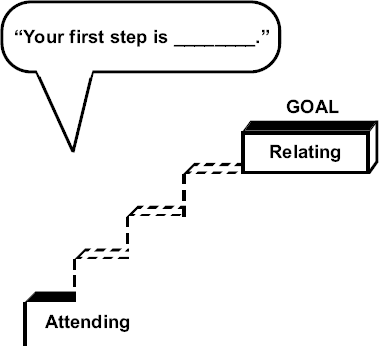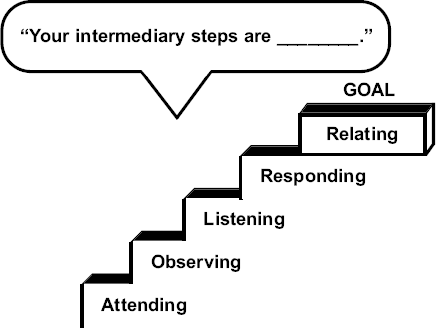In order to achieve the goals, we need to develop programs. Programs are simply step-by-step procedures for achieving the goals. Every step in the program should lead to accomplishing the goal.
Most programs are sequenced by contingency, i.e., each step is dependent upon the performance of the previous step. We determine what steps we must perform as preconditions for the next step. In this context, an action program consists of a well-defined goal, a basic first step, and intermediary and sub-steps, with each step being individualized for the helpee.

DEVELOPING PROGRAMS
The first step is the most basic step that the helpee must take. It should be the most fundamental building block in the program. This way we can build the other steps upon it. For example, if the goal is running a mile in eight minutes, the first step might be walking around the block. For some people, the first step to running a mile may be literally taking a first step.
For example: Bill feels disappointed because he cannot relate effectively with his parents and he really wants to learn how to relate effectively. For Bill, the first step in relating to his parents might be attending to them. In communicating the first step, we use a simple, straightforward format.

DEVELOPING INITIAL STEPS
Intermediary steps bridge the gap between the first step and the goal. We may determine an intermediary step that is approximately halfway between the first step and the goal. We may then continue our program development by filling in additional intermediary steps. For example, if the goal is running a mile in eight minutes, the intermediary steps might be running from one-quarter, to one-half, to three-quarters, to one mile and from twelve- to ten- to nine-to eight-minute miles
For our helpee, in learning to relate to his parents, the intermediary steps beyond attending might emphasize observing, listening and responding skills. In communicating the intermediary steps, we may use a direct, simple format.

DEVELOPING INTERMEDIARY STEPS
We continue to fill out our program by developing sub-steps. We develop sub-steps by treating each step in the program as a sub-goal and developing the initial and intermediary steps to achieving that sub-goal. We continue to do this until we have all the steps and sub-steps needed to achieve our goal. If we leave out a step or sub-step, our helpees will fail to achieve their goals. If we are planning to run a mile, we must develop distance and time sub-steps.
With our helpee, the steps to the goal of “relating” can be treated as sub-goals, and sub-steps can be developed to achieve these sub-goals just as we have in this book. In communicating the sub-steps, we use a simple format.

DEVELOPING SUB-STEPS
Some helpees cannot perform the steps as readily as others. They require programs individualized to their own particular learning or processing styles. This is essential as most programs are comprised of steps that are sequenced by contingency, where each step is dependent upon the performance of the previous step.
Every step of initiating should be individualized by checking back with the helpee. We check back with the helpee by making interchangeable responses that insure that we are in tune with the helpee’s frame of reference. Even when we individualize the sequencing of steps, we must stay finely tuned because this is a very subtle human process.
INDIVIDUALIZING STEPS
